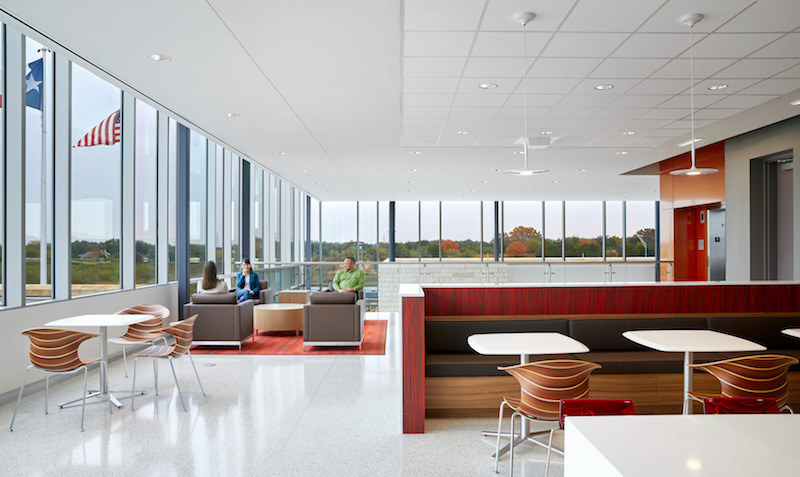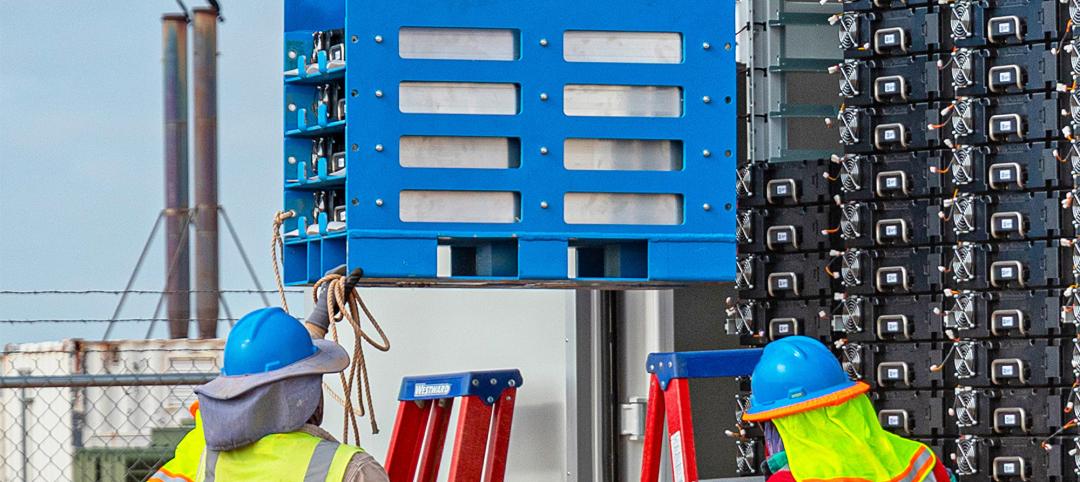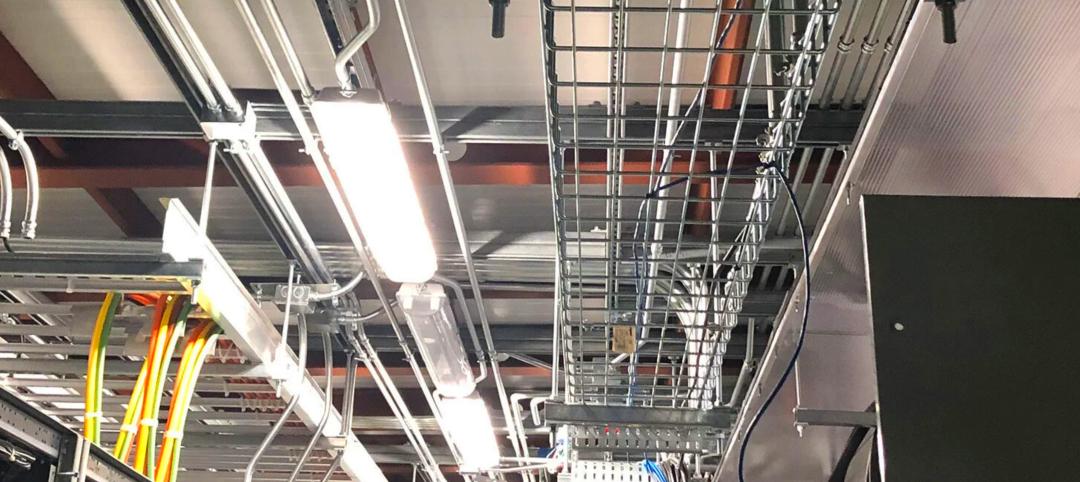Earlier this week, the $40 million, 80,527-sf Bexar Metro Regional Operations Center, a 911 call center that serves 2.5 million residents living in three counties around San Antonio, Texas—Bexar, Guadalupe, and Comal— officially went fully functional.
Within its hardened shell are Mission Critical components that include its emergency and network operations, two data centers, a redundant engineering system, and a Public Safety Answering Point (PSAP) with a 13,878-sf operations floor and 104 consoles. The electrical system meets Tier IV data center standards for maintaining operations regardless of the occurrence of any unplanned activity, and the mechanical system meets Tier III standards.
The building, on a 9.4-acre lot, can withstand Enhanced Fujita 3 (EF3) Scale impact rating wind and ballistic events.
While the most important consideration for building this facility was opportunities for redundancy and uninterrupted power, what separates this Operations Center from many other secured 911 call centers is its non-hardened area around the building’s interior periphery that provides employees—whose long work shifts are broken up by 15-minute breaks—a place where they can decompress, relax, and interact.
That area is a combination of administrative offices, conference rooms, multipurpose training rooms, break rooms, sleep areas, a gym, and kitchen. The building’s north façade is marked by an entry courtyard, an interior courtyard and a third exterior courtyard. Occupant wellness is further enhanced by a design that maximizes access to daylight and high indoor air quality.
“Our design goal was to ‘blend’ the hardened and non-hardened areas seamlessly,” says J.J. Puga, AIA, designer and project manager for Page Southerland Page, which provided architecture, interiors, MEP engineering, fire protection, and project management services. He points out that the design and configuration of the Operations Center dictate that employees must leave their workstations in order to take advantage of the more open, commodious areas.
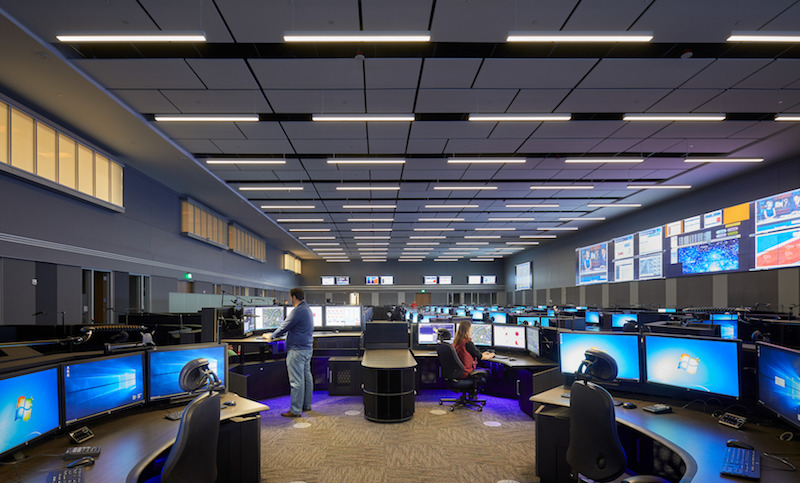
The 13,878-sf operations floor of the Bexar Metro 911 Regional Operations Center includes 104 consoles. Image: Courtesy Page
This building had been in the works for 15 years, but was waylaid until financial, logistical and territorial obstacles were cleared, explains Mike Pedigo, chief of staff for Bexar Metro 911 Network District, which owns the Operations Center.
Challenges included the initial resistance by the Edwards Aquifer Authority to allow the facility’s emergency generator fuel tanks to be installed on the site, for fear of spill containment and water contamination. Puga says Page ultimately demonstrated to the Authority’s satisfaction that the tanks would technically be above ground, and therefore legal within existing codes.
Construction of the Operations Center finally started in January 2015, and was funded through a surcharge fee to phone users within the jurisdiction.
The Building Team included Whiting-Turner (GC), Pape-Dawson Engineers (CE), Walter P. Moore (SE), Rialto Studios (landscape architect), TDSI (AV technology, data, security consultant), Wiss, Janney, Elstner Associates (roof consultant), and HeilExperts International (aeronautical consultant).
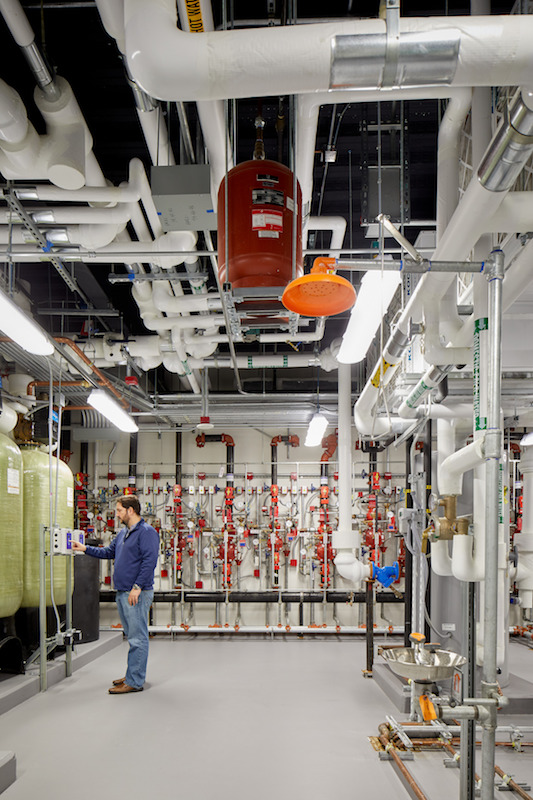
Mechanical and electrical redundancy are perhaps the most important reasons why this Operations Center was built. Two CPS Energy substations provide power to the site simultaneously. Image: Courtesy Page
The facility includes a helipad, at the insistence of Bill Buchholtz, Bexar Metro 911’s Executive Director. It also has 260 parking spaces and charging stations for electric cars and emergency vehicles.
The facility—also known as Quarry Run Operations Center—supports the Bexar County Sheriff’s office and the three counties’ fire and police departments, which provide the facility’s personnel. Prior to the opening of the Operations Center, 911 calls had been handled through 25 different locations within the jurisdiction of the Bexar Metro 911 Network District.
Pedigo says the 150-plus people who work in this building required “a lot of preparation” in terms of learning how to manage a facility of this magnitude. A new 911 system was installed, which also required training.
In early August, this facility is scheduled to become a backup 911 call center for the city of San Antonio, a switch that Pedigo anticipates could take as much as 18 months to fully integrate.
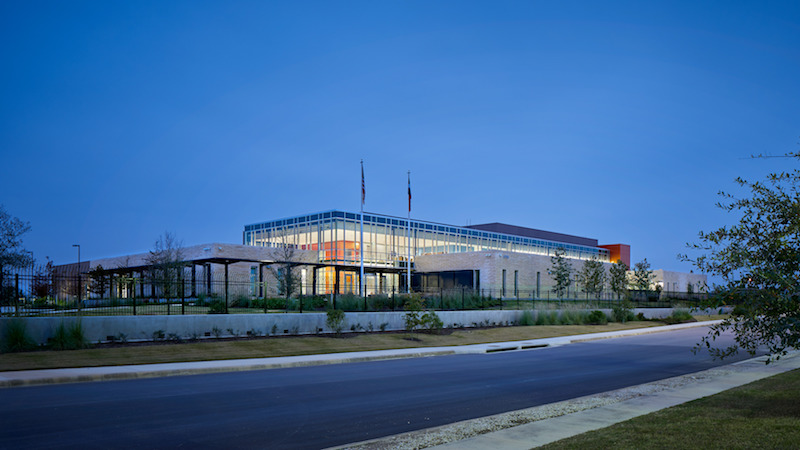
The Operations Center, which sits on a 9.4-acre lot, this summer will start serving as a backup for the city of San Antonio. Image: Courtesy of Page
Related Stories
Giants 400 | Aug 22, 2023
2023 Giants 400 Report: Ranking the nation's largest architecture, engineering, and construction firms
A record 552 AEC firms submitted data for BD+C's 2023 Giants 400 Report. The final report includes 137 rankings across 25 building sectors and specialty categories.
Giants 400 | Aug 22, 2023
Top 175 Architecture Firms for 2023
Gensler, HKS, Perkins&Will, Corgan, and Perkins Eastman top the rankings of the nation's largest architecture firms for nonresidential building and multifamily housing work, as reported in Building Design+Construction's 2023 Giants 400 Report.
Market Data | Aug 1, 2023
Nonresidential construction spending increases slightly in June
National nonresidential construction spending increased 0.1% in June, according to an Associated Builders and Contractors analysis of data published today by the U.S. Census Bureau. Spending is up 18% over the past 12 months. On a seasonally adjusted annualized basis, nonresidential spending totaled $1.07 trillion in June.
Data Centers | Apr 14, 2023
JLL's data center outlook: Cloud computing, AI driving exponential growth for data center industry
According to JLL’s new Global Data Center Outlook, the mass adoption of cloud computing and artificial intelligence (AI) is driving exponential growth for the data center industry, with hyperscale and edge computing leading investor demand.
Sustainability | Apr 4, 2023
NIBS report: Decarbonizing the U.S. building sector will require massive, coordinated effort
Decarbonizing the building sector will require a massive, strategic, and coordinated effort by the public and private sectors, according to a report by the National Institute of Building Sciences (NIBS).
Energy | Mar 20, 2023
Battery energy storage market predictions are trickier than ever
Burns & McDonnell breaks down the state of battery energy storage today, from pricing concerns to alternative solutions.
Giants 400 | Feb 9, 2023
New Giants 400 download: Get the complete at-a-glance 2022 Giants 400 rankings in Excel
See how your architecture, engineering, or construction firm stacks up against the nation's AEC Giants. For more than 45 years, the editors of Building Design+Construction have surveyed the largest AEC firms in the U.S./Canada to create the annual Giants 400 report. This year, a record 519 firms participated in the Giants 400 report. The final report includes 137 rankings across 25 building sectors and specialty categories.
Data Centers | Feb 6, 2023
Modular electric rooms are the new normal
Southland Industries breaks down the prefabrication benefits of Modular Electric Rooms (MERs).
Sponsored | Resiliency | Dec 14, 2022
Flood protection: What building owners need to know to protect their properties
This course from Walter P Moore examines numerous flood protection approaches and building owner needs before delving into the flood protection process. Determining the flood resilience of a property can provide a good understanding of risk associated costs.
Data Centers | Nov 28, 2022
Data centers are a hot market—don't waste the heat!
SmithGroup's Brian Rener shares a few ways to integrate data centers in mixed-use sites, utilizing waste heat to optimize the energy demands of the buildings.


